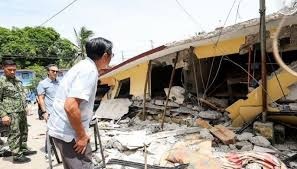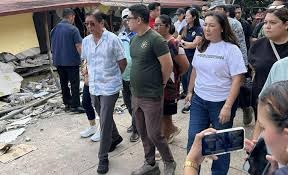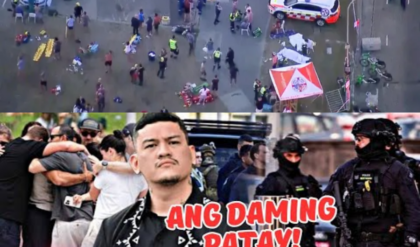CEBU CITY, Philippines — In a clear demonstration of the administration’s focus on disaster recovery, President Ferdinand Marcos Jr. conducted an on-the-ground inspection of relief and rehabilitation operations in the municipalities of San Remigio and Bogo City in northern Cebu on Friday. His visit aimed to personally oversee the progress of the government’s comprehensive response to families severely impacted by the recent devastating 6.9-magnitude earthquake.

The President’s presence, which included a high-level delegation of key cabinet members, served to both reassure affected residents and accelerate the transition from immediate, short-term relief to sustainable, long-term housing solutions.
San Remigio: The Pivot to Permanent Housing
President Marcos Jr.’s first stop was the municipality of San Remigio, where the centerpiece of the recovery effort, the Bayanihan Village, is rapidly taking shape. This site is designated as a crucial relocation area intended to provide temporary, yet durable, housing for residents who were displaced or whose homes were either completely destroyed or situated within declared danger zones.
The President was accompanied by Department of Social Welfare and Development (DSWD) Secretary Rex Gatchalian, Department of Public Works and Highways (DPWH) Secretary Vince Dizon, and various local government officials. Their collective visit underscored the multi-agency approach required for effective post-disaster recovery.
The Bayanihan Village Project
The core of the San Remigio project involves the installation of 67 prefabricated modular shelter units. These structures, designed to be safer and more comfortable than the makeshift tents initially used, represent a significant upgrade in living conditions for the victims.
Eva Marie Marfil, Regional Director of the Department of Human Settlements and Urban Development (DHSUD-7), provided an encouraging progress report. She confirmed that out of the 67 planned “Smart Houses,” 45 units are now fully ready for occupancy. As of the inspection date, 22 families have already successfully moved into the site, marking a vital step toward normalization.
The Bayanihan Village Project is currently benefiting a subset of the 254 families affected by the recent tremor across northern Cebu. The swift construction and mobilization effort illustrate the government’s commitment to expediting the housing process, particularly in moving vulnerable populations out of precarious temporary dwellings.
Bogo City: The Dual Track of Recovery
The presidential entourage then proceeded to Bogo City, where the focus shifted to addressing the immediate needs of families still residing in provisional accommodations while simultaneously initiating the rebuilding process.
Tent City Status and Transition
The President visited the Tent City in Bogo, which currently houses 176 tents accommodating 162 displaced families. While the tents serve a critical purpose as immediate shelter, the administration is pushing for a rapid transition to more permanent solutions.
Crucially, President Marcos Jr. reported a major development aimed at empowering residents to rebuild: the DHSUD has commenced the provision of construction materials directly to affected residents. This strategy allows families to take ownership of the reconstruction process, tailored to their specific needs and properties, while receiving vital material support from the government.
During his engagement with the residents and local officials, Mr. Marcos offered assurances, emphasizing the continuity and breadth of the government’s support:
“We will keep working to make sure everybody is okay, everybody is healthy, everybody has what they need.”
This commitment encompasses not just housing but also addressing health and livelihood concerns that typically plague disaster-hit areas.
Assurance of Steadfast Commitment

The earthquake, registering a significant 6.9 magnitude, caused widespread damage to homes and infrastructure, displacing hundreds of families and disrupting daily life across northern Cebu. The President’s direct involvement underscores the national government’s recognition of the severity of the impact and the necessity of a coordinated, long-term recovery strategy.
Mr. Marcos assured the public that the government remains “steadfast in its commitment” to extend comprehensive support to the quake-hit communities. This commitment is articulated through a multi-phased approach:
-
Immediate Relief: Providing initial aid, food packs, medical attention, and establishing safe tent cities.
Transitional Housing: The construction and deployment of modular shelters like those in the Bayanihan Village.
Long-Term Rebuilding: Providing materials and technical assistance (DHSUD’s role) to help families permanently reconstruct their homes.
Infrastructure Repair: DPWH’s mandate to repair damaged roads, bridges, and public buildings essential for economic recovery.
The successful implementation of projects like the Bayanihan Village and the timely distribution of construction materials will be key benchmarks for the administration’s effectiveness. The administration is focused on ensuring that the recovery process is not just fast, but also equitable and resilient, ultimately helping affected communities build back stronger than before the earthquake. The President’s visit served as an official mandate to his cabinet secretaries and local leaders to maintain this momentum until all displaced families are safe and securely sheltered.





